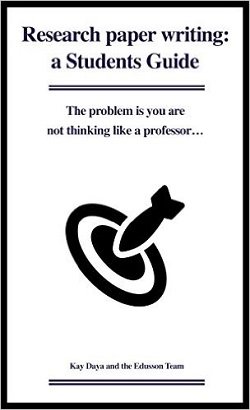These two research papers differ in terms of format and structure. The field, the level of expertise, and assignment instructions determine which one you write.
A General Research Paper
This format is appropriate for writing in the humanities. Logical arrangement and critical analysis help readers to understand your deductions. A general research paper contains three main sections — an introduction, body paragraphs, and a conclusion. You also need to consider if the paper is argumentative, analytical, or one of the other types.

Want to know more about how to write a Research paper?
Read an Ebook created by Edusson.com
Click below to find it out :
” Research Paper Writing: a Student’s Guide “
Introduction
An introduction provides background information to establish context. Define key terms or concepts here too. The most important sentence is the thesis statement which reveals the goal of your research or the argument you will make.
Writing tip: Create a thesis statement by formulating a question that your paper will answer. For example — How has Facebook changed the way people communicate nowadays? The answer to that question is the thesis statement for this topic.
Body
Here is where a strong outline makes writing easier. You know the number of body paragraphs to include. You have a main idea for each body paragraph as well as its supporting information, and you can integrate your sources to support claims. Remember you don’t summarize sources. You analyze, deconstruct, compare and explain them in order to lend weight to your paragraphs and, ultimately, your thesis statement. The number of body paragraphs depends on the depth of research. Longer projects need several headings and subheadings in the body.
Conclusion
End your paper with a conclusion that rephrases the thesis statement and summarizes main points. Explain your deductions and suggest areas of the topic that can be researched next.
A Scientific Research Paper
A scientific research paper uses a more rigid structure to present findings and methods. This creates a system of uniformity to deliver data to the scientific community. Because of its structure, people can obtain information from a scientific paper in different ways — they can browse the abstract or go straight to tables and results. These are the main sections:
Title
The title describes the contents of your paper in a cohesive manner. The author’s name and institution appear below the title.
Abstract
This is a short but detailed paragraph summarizing the whole paper. Write this when your paper is complete because you might change sections as work progresses. An abstract should contain:
- The purpose of your paper
- The model or methodology used for findings
- Key results
- Conclusions based on your findings
The normal length of an abstract is 200-300 words, but you should be as concise as possible. Use the past tense and offer an independent, comprehensive summary of your research methods and results. Make sure your abstract agrees with what you have written in your paper. Here’s a detailed look at an abstract.
Introduction
An introduction states why you conducted your research, and it gives context. It does this by:
- Outlining existing knowledge on the topic, citing sources of information
- Offering a brief statement on how you approached your research
- Stating the purpose of your research — Do this by:
- presenting a hypothesis that your paper proves or disproves
- posing a question your paper answers
- Stating a problem you paper addresses
An effective introduction gives readers adequate background. It should raise curiosity about your findings and entice them to read more.
Materials and Method
This section is necessary because it shows how dependable your findings are. The content of this section changes according to the research you conducted — experiments and field studies differ in terms of methodology. Here is a detailed breakdown of what to include in this part of the paper.
Results
You state results of your research in this section without interpreting them. It is full disclosure of occurrences. The most effective way to do this is through tables, charts, and graphs to complement your text. Your text should point to the discussion section where results are interpreted. Include negative results, if any. This shows objectivity and lends weight to your paper.
Discussion
Dissect results in this section. Detail how your findings answered the question or issue raised in the introduction. Propose how your results affected existing knowledge and discuss your findings in the context of previous studies where appropriate. This section often earns the most points because it shows the relevance and validity of your research. You should:
- Begin with a summary of results
- Show how your findings affect your hypothesis
- Discuss your findings — interpret, explain and justify them
- Point out similarities or differences with other research in the field
- Mention any shortcomings of methods and their possible effects on your results
- Suggest areas to investigate in the future
Conclusion
A conclusion should do the following:
- Remind readers of the topic
- Summarize results concisely
- Point out any negative results. This calls for peers to pick up the research where you left off and continue to explore the issue.
References
Include a list of works cited at the end of your paper. It’s necessary to give due recognition to authors of other works you used for primary and secondary sources to avoid plagiarism. Your paper is invalid if it incorporates someone else’s original content without referencing them. Three main citation formats are: MLA (Modern Language Association) APA (American Psychological Association) The Chicago Manual of Style Your instructor should tell you which format to use. Check the specifics of the style and make sure you are accurate when composing sources.
Writing Tip: Online tools, such as citation generators, are useful to incorporate all necessary data into a reference. The sections listed above for scientific research papers are commonplace. Depending on the length and depth of your paper, other sections, such as Appendices and Acknowledgments, are also possible.
Don’t forget to consider your audience when writing a research paper. Adapt information accordingly, deciding if certain terms should be explained or not. A general audience or a specific audience will affect the language you use — technical terms, for example. You may need to include or exclude information too.








